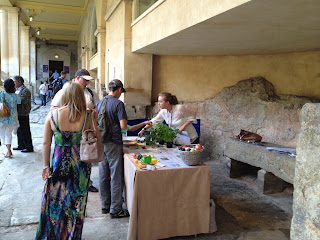Many medicines would contain a variety of ingredients, with different parts of the plant being crushed into powder (in a mortarium) and then mixed with oil to apply externally or added to wine to make a liquid remedy. Plant material was boiled down to create a liquid or a paste and often honey would be added as a sweetener to a medicine meant to be drunk.
 |
| Acanthus |
• Acanthus was usually a decorative plant but its roots could be cooked and applied as a poultice for burns, sprains and gouty limbs
• Basil was eaten to ease flatulence
• Cabbage in various forms has been accorded no less than 87 different cures ranging from ingestion, infusion and application by Pliny the Elder
• Hemp/Cannabis ripe seeds were used as a contraceptive
• Hollyhock, even though more commonly used as a herb, was also made into an ointment to treat wasp and bee stings
• Marsh Mallow was crushed and boiled in wine, which thickened due to the mallow,and was applied to the skin as a poultice to treat bruises and tumours, or could be drunk to soothe toothache
• Mustard was used to cure snake bites, mushroom poisoning, toothache and stomach ailments, to soothe asthma, epilepsy, bruises and sprains
• Onion, due to its eye-watering effect, was thought to improve poor vision and if mixed with rue and salt it was applied onto dog bites
• Sweet Flag could be used on its own or in combination with terebinth-resin (turpentine) to treat coughs, with the smoke being inhaled through a funnel
• Valerian, just as today, was used as a sleep-inducing medicine, with its petals being scattered between bed sheets. It could also be used as a dusting powder if dried and mixed with dried lily petals
• Willow contains salicylic acid, the main ingredient in Aspirin, and was used to treat fever and pain
Julie







